|
St. Lucia's exquisite beauty and serenity belie a history marred by
constant war and bloodshed. Even before the advent of the European
conquest of the New World, St. Lucia had already been victimized by the
ongoing struggle between bellicose Amerindian tribes for control of the
island.
The original settlers of the island migrated from the northeastern
shores of the South American continent between 1000 and 500 B.C. These
people were simple farmers and fishermen. Today, over 12 archaeological
sites on the island bear witness to this ancient civilization. Remains of
their culture consist primarily of domestic and ceremonial artefacts,
ceramic objects and enigmatic cave drawings.
|
|
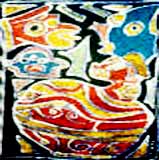 |
By the ninth century A.D., the Carib Indians had begun to advance
through the southern Caribbean islands. These fierce warriors also
migrated from South America, but their rapid rise to supremacy was
achieved in a relatively short time. When the first Europeans arrived, it
was the Caribs who greeted them. These encounters were rarely amicable.
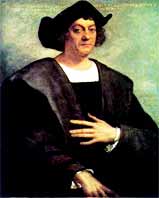 |
|
Just which European discovered St. Lucia is still in question.
Christopher Columbus has traditionally been given credit for the
discovery, supposedly made during his fourth voyage in 1502, but recently
uncovered evidence suggests otherwise. The discovery of the island of St.
Lucia by the Europeans is steeped in ambiguity. Some historians believe
Columbus landed there on December 13, 1502, but other records show
Columbus could not have been anywhere near the island on that date. Many
historians now believe St. Lucia was actually discovered by Juan de la
Cosa, Columbus' navigator, in 1499. At any rate, St. Lucians still
celebrate Discovery Day as December 13, 1502.
Another version attributes the discovery to the French. According to
local tradition, a group of shipwrecked French sailors landed here
on December 13, 1502, the feast day of St. Lucia. |
|
The fact that throws everyone off is that the island of St. Lucia
appears on a Vatican globe dated 1502.Jambe de Bois ("Wooden Leg"), a French pirate, used the island as a
base for his attacks on Spanish ships in the early 1550s. Later, the Dutch
established a fortress at Vieux Fort. However, the first real attempt at
colonizing the island occurred in 1605, with the arrival of 67 English
settlers aboard the ship Olive Branch. The ship had in fact been on its
way to Guiana when it was blown off course and landed in Vieux Fort. At first, the Caribs
welcomed the new settlers and sold them several huts. |
|
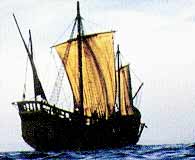 |
Tensions soon rose between them,
however. In less than five weeks there were only 19 settlers left alive;
the survivors barely managed to escape in a canoe. They landed in
Venezuela, and years later, one of them, John Nicholls wrote the story of
their misadventure.
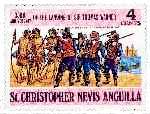 |
|
A subsequent attempt at colonization was made in 1639 by Sir Thomas
Warner, who on January 28th 1623 had landed on St Kitts with his wife,
son and a party of thirteen. Warner started a settlement on Nevis in
1628. Belain d’Esnambuc attacked the English in 1629 and regular
skirmishes between the two occurred over the course of the next seven
years. Sir Thomas Warner died in 1648 Some 400 settlers arrived, but in less than 18 months the colony
was exterminated by the Caribs.) |
With this second failure, the British decided to give up trying to
settle St. Lucia. But no sooner did they do so than the French moved in.
At her head of the expedition was a man named Rousselan, a French
officer married to a Carib woman. He made peace with the Caribs and
established the first permanent settlement on the island. After Rousselan's death in 1654, the Caribs resumed their attacks
on the colony. Nevertheless, it soon became apparent to them that the
Europeans had come to stay.
|
Jealous of the French success on St. Lucia, the British again laid
claim to the island in 1659, initiating almost two centuries of continuous
warfare. The island changed hands a total of 14 times before it was
finally ceded to the English in 1814.Despite the wars and flag changes, St. Lucia became an important
sugar-producing island. The first plantation was started by two Frenchmen
in 1765.
Fifteen years later, there were nearly 50 estates in operation. One of
these, Paix Bouche, is reputed to be the birthplace of Napoléon's first
empress, Joséphine, born on June 23, 1763.
The ruins of the estate case still be seen today.
|
|
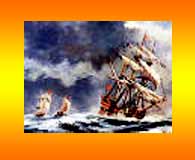 |
 |
|
It should be noted that most historians believe the future empress
was born in La Pagerie on
the island of Martinique.
African slaves were imported to supply the necessary manpower required
by the huge sugar plantations. When the slaves were finally emancipated in
1838, they accounted for almost 90% of the population.
Once it was firmly in British hands following the Napoleonic Wars,
St. Lucia became part of the Windward Islands, with the seat of
government on Barbados.
|
|
Though English was established as the official language, it was
impossible to eradicate the influence of French culture on the island. Even today, almost every St. Lucian speaks a patois, a Creole version
of French. Many of the names of the island's cities and villages are
French. And unlike that of most former British colonies, the population is
still primarily Roman Catholic.
In 1979, the last colonial link between Great Britain and St. Lucia was
severed when the island achieved full independence. In that same year it
became a member of the British Commonwealth of Nations.
|
|
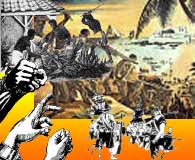 |
History of African Slavery in the Caribbean
It was Columbus and his adventures
throughout the Caribbean between 1492 and 1498 that first brought
Europeans to the Islands, and very soon after they settled the colonies,
the need was apparent for labour to expand trade. The original
inhabitants, the Tainos who from all accounts were a peaceful tribe, and
the Caribs, who were a warlike tribe were found to be unsuitable for
slave labour, so were systematically wiped out by the invaders. Guiana
and Trinidad are now the only two islands that can boast descendants of
these original natives. Slavery was, of course already well established
on the west coast of Africa was the logical choice for the new
plantation owners and for over 300 years from Columbus's second voyage
in 1496, Africans were transported to provide free labour to satisfy the
European demand for sugar, coffee, cotton and cacao of the Caribbean. So
great was the demand for labour, that between 1776 and 1848, over
4000,000 slaves out of a total population of 5000,000 were working
throughout the Caribbean. The high ratio of slaves to owners and their
overseers, the harsh and brutal treatment, as well as absentee
landowners made rebellion inevitable, with slaves performing self
mutilation, suicide and killing their children to escape bondage, as
well as escaping and living wild in the forests, (maroonage) forming
their own communities. Slave revolts were endemic throughout with
Jamaica holding the record of serious uprisings, and on Guiana, a slave
actually became governor after a revolt in 1763.
Emancipation came in 1838, with £20,000,000 being paid to the planters
in compensation, and workers were still virtual slaves as the plantation
owners had the monopoly on jobs. To add to the problems, indentured
labourers from India, another of Britain's colonies came to the
Caribbean in 1844, and kept arriving for the next 73 years. By the time
this immigration period had ended over 400,000 Indians had set up home
mainly in Trinidad, Guiana and Jamaica. |